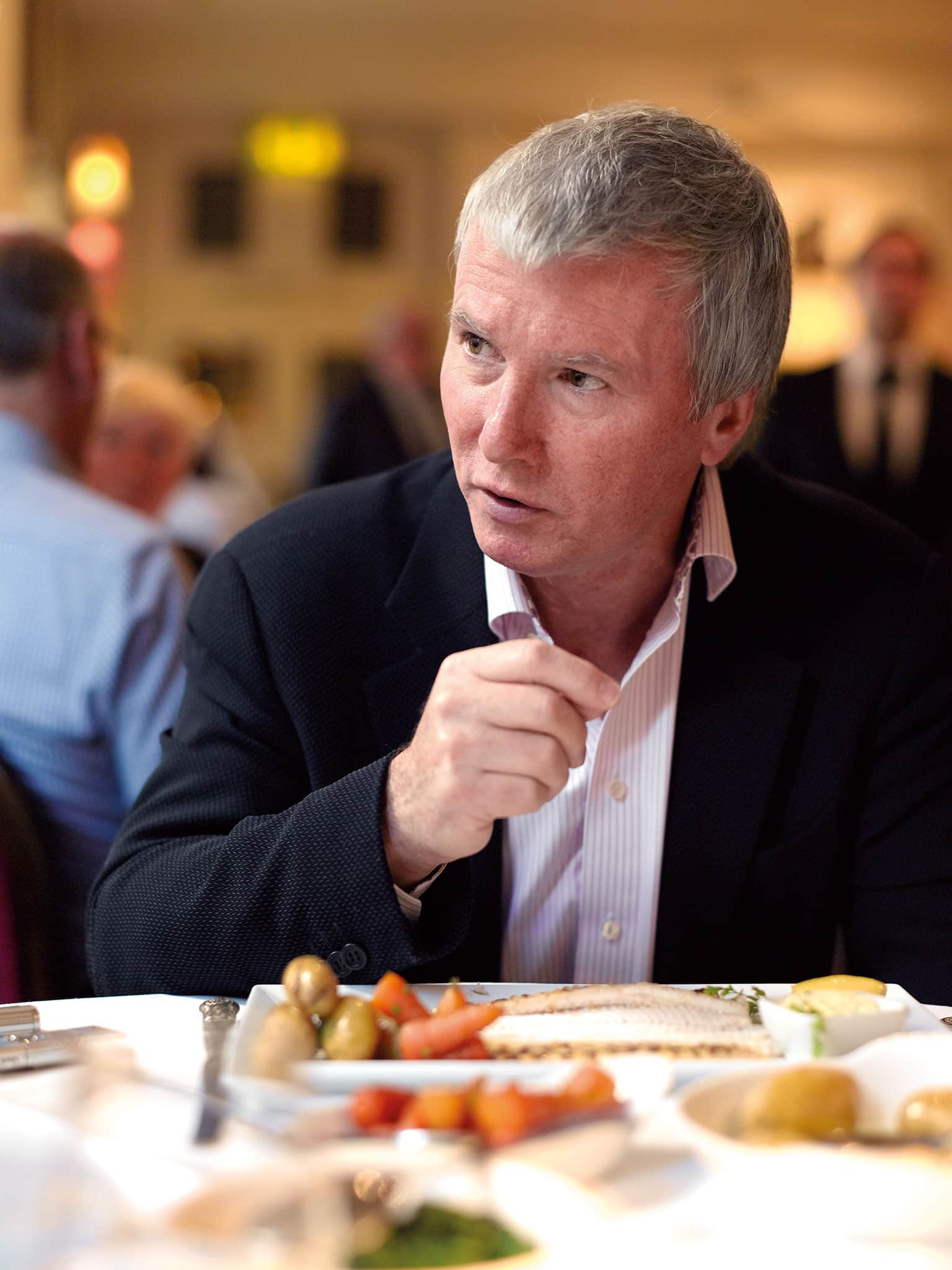Lunch With... Steve Soper
This serial race winner and straight talker remained a factory driver for almost 20 years. No shortage of anecdotes here, then...
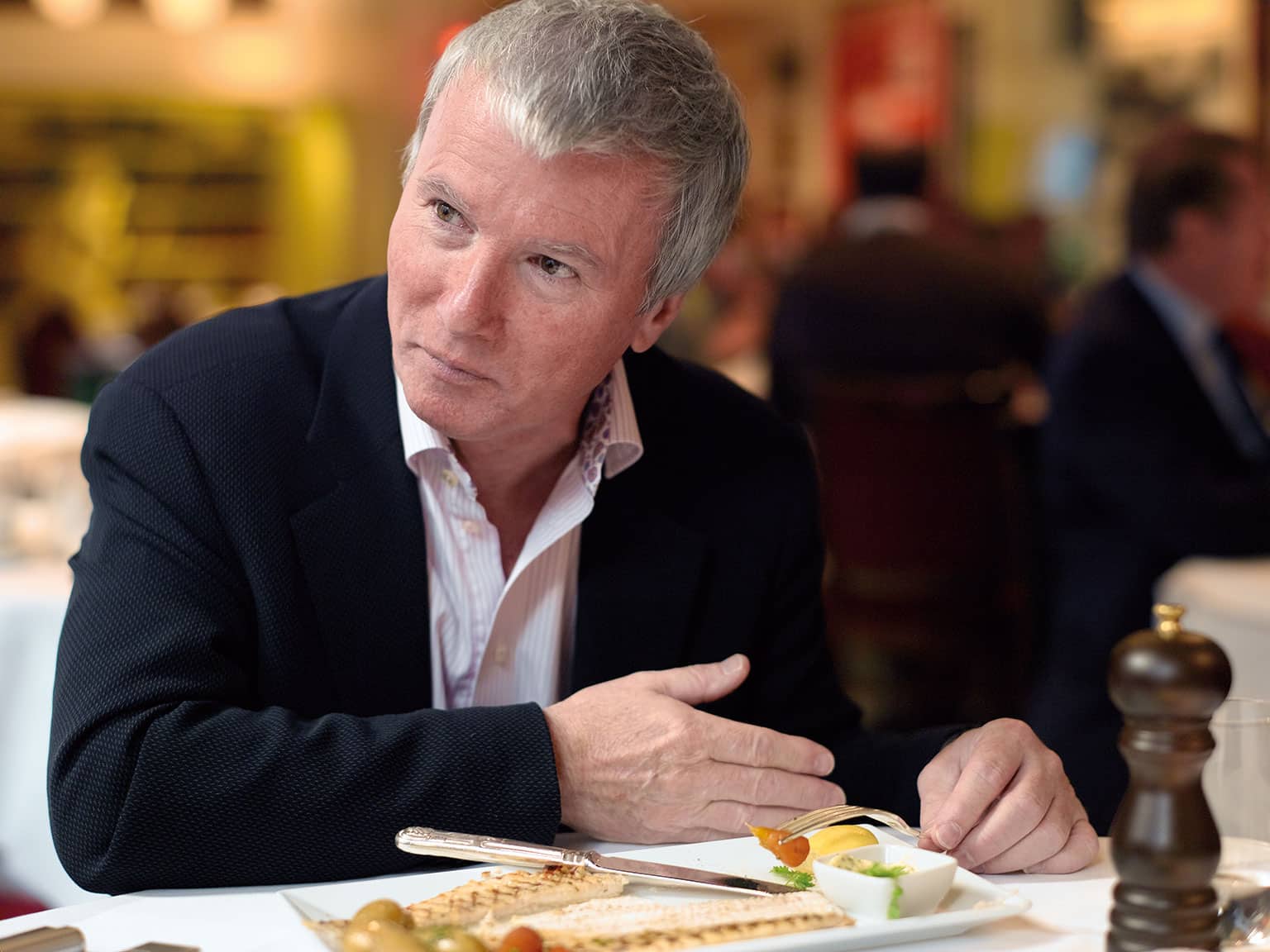
James Mitchell
Most of the best drivers who earn their living in sports or touring cars have at least cut their teeth in the single-seater formulae. Steve Soper is different. This man racked up a fine career over more than 20 years, yet never raced an open-wheeler. And he was into his 30s before anyone ever paid him to drive. Until then he had to earn enough folding from kerbside car trading to pay for his weekend fun.
Yet he went on to works drives for BMW, Ford and Rover, endurance classics with a front-running McLaren and victories in Britain, Europe, North America and the Far East. The championship titles somehow never seemed to go his way, and his only British crown was taken away months later on a technicality. But when Motor Sport cast votes among pundits for their greatest ever touring car driver back in 2005, he was the clear winner. Obviously Steve is a man eminently worth taking to lunch.
His choice is Langan’s Brasserie in London’s Mayfair, a favourite watering-hole for the unofficial Brit brat-pack, of which Steve has long been a member along with Damon Hill, Johnny Herbert, Mark Blundell, Julian Bailey and Perry McCarthy. Crab and avocado salad, excellent grilled Dover sole and old-fashioned apple pie and ice cream help things along.
Steve’s father ran a small tyre shop in Kenton, Middlesex, and did sprints and slaloms with the Harrow Car Club. When Steve was 14 he borrowed his dad’s competition licence and did an autotest event on grass in his mother’s Hillman Imp. “I could barely see over the steering wheel, but the HCC turned a blind eye: they’d seen a licence and a signature, so if anything went wrong they could say it wasn’t their fault. Things were different in the 1960s. I’d already crashed my father’s Jaguar 3.4 driving it into his little workshop. In a panic I stamped on the accelerator instead of the brake, lit up the rear tyres and went straight through the back wall. All he said was, through gritted teeth, ‘Just go away and let me cool down’. My parents were great.

Mini 1275GT at Silverstone in 1977. He won the Leyland Challenge outright two years later
Motorsport Images
“I didn’t get on well at school. When the teacher went around the class, pupil by pupil, my technique was to misbehave and get sent out before he got to me. When I left at 15 I still couldn’t read. I taught myself to read much later, spelling out what the weekly comics said about my races.” Steve now owns and runs a highly profitable business with two BMW dealerships, a staff of 200 and an annual turnover of £100 million. Clearly his difficulties at school were no guide to his intelligence.
“As soon as I was old enough I had scooters and motorbikes, and an Isetta bubble car: that fell over the first day I had it. Then I got a well-used Ford Escort GT and, of course, I wanted to race it. My dad would never give me any money for that, but he helped me in every other way, mending the engine when it broke or fitting a limited-slip diff. I worked for him for seven years, but it got a bit fiery because he was a trained toolmaker, always doing everything the correct way, and I was young and impatient, wanting to cut corners and do it all quick and cheap. But we’d work together on my car late into the night, and he kept me grounded. He’d say: ‘You can’t have a nice road car, and a racing car, and a girlfriend. You’ve got to pick one. And only go racing to enjoy yourself. Don’t think you can make a living at it’. It took me a long time to prove him wrong on that.
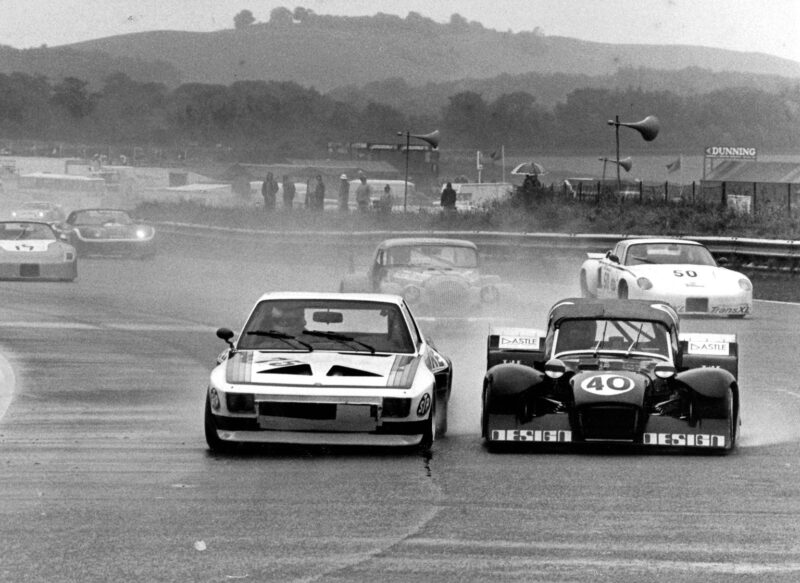
In Radbourne’s Fiat X1/9 fighting Rob Cox-Allison’s “black brick” Caterham in 1981
Motorsport Images
“My first race was the Silverstone Eight Clubs. I’d put big arches on the Escort – I’d taught myself to panel-beat and paint – so it looked good, but it still had the little 1300 pushrod engine. The flag falls, off we go into Copse with me trying to pass as many cars as possible, and I collide with a Jaguar XK. The Escort falls over and lands upside down in the middle of the track. I’ve got no seat belts and no roll-over bar, and the roof is flattened down to the bonnet. I crawl out in a daze and instead of going towards the nearest verge I wander off towards the other side, and the rest of the grid’s still coming. So, having nearly killed myself going upside down, I almost get myself run over.
“Next I got a stripped Mini-Cooper, very light, all ally, beam rear axle. Back to Silverstone, first outing, first lap of practice, I get as far as Maggotts and I’m in the barriers. Have to drag the wreck home. I was getting a bit disheartened now. Then I got an 850 Imp off a friend and took it to Thruxton. It was pouring, I’m driving my heart out nearly going off at every corner and I was lapped almost at once. Very depressing. But I lowered the suspension, put more camber on the front, bought some cast-off F3 slicks and put them on narrower rims. Then I borrowed £200 off my dad, scrounged another £200 from somewhere, and bought a George Bevan-prepared engine. Suddenly I found out how it felt to fight for the lead. I had five wins in that car.
“But Special Saloons was getting very competitive – people putting Ford blocks into Minis, that kind of thing – and I realised one-make racing was more affordable. In 1976 I got a Mini 1275GT and Richard Longman did me an engine. In 1977 I won the class, in 1978 I had a couple of good accidents and then in 1979 I won the Leyland Challenge outright. The prize was a brand-new 1275GT road car, which I sold immediately to fund the next season.
“I was now car trading full-time to support my racing. Showrooms always had part-exchanges to unload, other dealers hadn’t got time to go around sourcing stock, and if I got them a car clean and ready to sell I could usually make a profit of £150 a car. In a good week I’d clean up and move six cars. Hard work, but then I could clear off on Friday afternoon and go racing. I didn’t always get it right: sometimes I’d lose money on a car. But it really taught me how much a pound was worth.
“The Ford Fiesta series was being launched and I found somebody to lend me a car if I supplied the engine. I got Minister to do that because they were winning in Formula Ford. Then I met John and Geoff Anstead, who ran Radbourne Racing, the Abarth people. They had a very standard Fiat X1/9 and I was quite competitive in that, so they got Dallara to build them a lovely little full-race X1/9 to STP modsports regs. In 1980 we won our class in the STP, and we won the Fiesta Challenge too, even though I had to miss some rounds because of clashes with the STP. For 1981 someone else offered me a car for the Metro Challenge. No financial input from me, I just had to turn up. So I won that, which brought me another prize car to sell, and with the X1/9 I won my class in the Donington GT series.
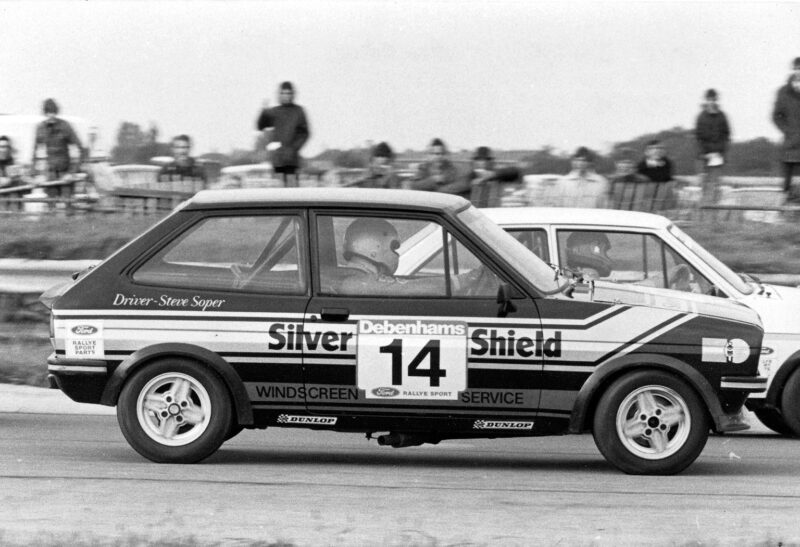
En route to 1980- Ford Fiesta title
Motorsport Images
One Sunday, because of clashes between the two championships, I hired a helicopter to get me between circuits. It cost £350, a lot of money then, and people thought I had a rich mum and dad who were bank-rolling me. But it was all done with trading, ducking and diving.
“By now John Davenport, director of Austin Rover Motorsport, was taking a bit of notice. In the 1982 British Saloon Championship ARM was running two Richard Longman MG Metros sponsored by Datapost, Esso and Hepolite, and I heard John say he thought they looked like Christmas trees with all that sponsorship. So I went to work on Hepolite. I got a shell and some engines out of Davenport, Hepolite came over to me, and we built up a Group 1 Metro. In 11 rounds I won five, Longman in the works car won five. I was unlucky not to win the class and I was third in the series overall. Suddenly things started to happen. Hepolite wanted to move up to the big cars for 1983 and Davenport told them, ‘We’ll put a Rover out there in your own livery, and Soper can drive it’.”
The Hepolite Rover was run by Tom Walkinshaw alongside his two Sanyo-backed Rovers for Peter Lovett and Jeff Allam, and Steve raised a lot of eyebrows by winning the first round from pole, in streaming wet conditions, then winning four more – and taking the British Saloon Car Championship outright. “It was the first time I’d raced a car with lots of horsepower. After all these little one-make things, when every overtaking manoeuvre needed several laps of forward planning, I couldn’t believe how easy it was. It was a big, heavy car and you just slid it around.
“Not so easy was working with Tom. He gave me a beautifully prepared, highly competitive car. But I hadn’t come up through his ranks. I wasn’t a Win Percy and we didn’t understand each other. I admired how he built great racing cars, I admired the business he’d built, but I struggled to respect some of how he did it.
“We also did some European Touring Car races, but Tom was running the Jaguar XJ-Ss as well, so he controlled what we were and were not allowed to do. It was the first time I’d been exposed to politics in motor racing, and I didn’t get it. But I went to the Nürburgring for the first time, tried to learn the circuit going around and around in a Maestro, and in the race I was running third behind Tom’s Jaguar and Manfred Winkelhock’s BMW. I lined myself up for a move to pass Manfred going into a fourth-gear corner that turned out to be a third-gear corner, and I went off. Just lack of circuit knowledge. I got the car back to the pits but we had to retire.” More pleasing was the Tourist Trophy: Steve qualified 0.01sec off Tom’s XJ-S pole and, sharing with René Metge in the 315-mile race, he scored a brilliant win.
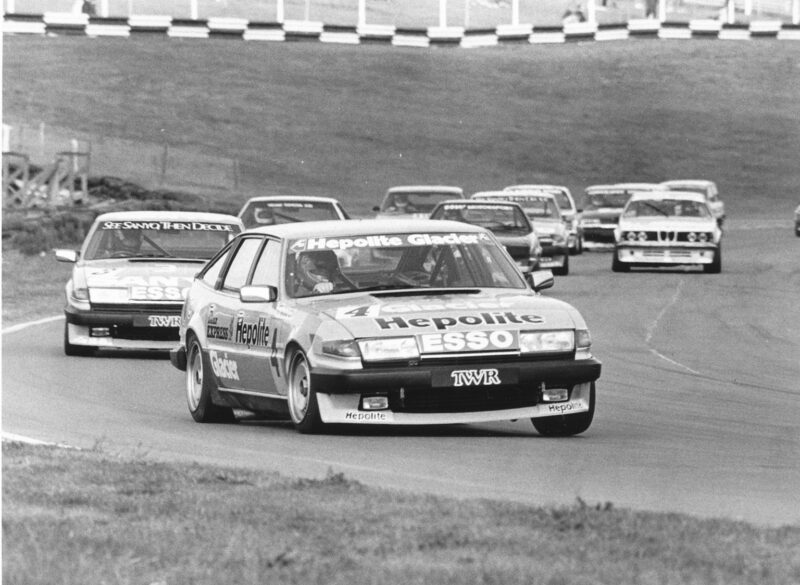
Soper was initially crowned BSC champion in 1983, but TWR Rover was later excluded for technical reasons
Motorsport Images
Also in 1983 Steve had his first major sports car drive, in the Le Mans 24 Hours. “Mazda had a two-car works entry. One car had three Japanese in it, and the other had James Weaver, Jeff Allam and me. During practice we found the car wandered about all over the road. On the Mulsanne at 200mph, with no chicanes then, you needed a lot of lock to stay on the road. James is like me, self-taught, and says what he thinks. We wanted to put some toe-in on the front, we wanted to make up a front splitter, but the Japanese engineers said nothing could be changed, the car had to stay exactly as it was. They’d designed and built this car, we just had to drive it. It was so bad, none of us wanted to get in it. I out-qualified the other Mazda, but James, Jeff and I reckoned it was dangerous, and we agreed we should try to retire it as soon as possible.
“So we turned the rev-limiter switch to the qualifying setting to blow it up as soon as possible, we mullered the gearbox, we hit every kerb we could. And that bloody thing just kept going. We would have won the class if Jeff hadn’t had to do a whole lap with a deflated tyre, which smashed up the bodywork. As it was we finished second. But going around in the middle of the night, looking in the mirror for the Porsche 956s and trying to stay on the road, I promised myself, ‘If I survive this weekend I will never do this race again’.”
After a Grovewood commendation for his efforts in 1981, Steve’s British saloon title earned him a full Grovewood Award for his 1983 season. His ETC performances, particularly against Hans Stuck’s BMW 635, had been noted in Munich, and Stuck himself advised BMW racing boss Dieter Stappert to take a look at this Englishman. “So for 1984 BMW came after me with a works contract as team-mate to Stuck, Quester and Winkelhock, offering me twice what I was earning with Tom. Just over a year before I’d been pissing about in Metros, so it all seemed very exciting. But I still had a strong relationship with John Davenport, and he trumped BMW with a three-year deal, so I decided to stay.
“Then, well into the 1984 season, I lost my 1983 British title over a protest about the Rover’s legality. Tom was very clever at building his cars to exploit the rules to their utmost, but he upset quite a few people along the way. Whenever Frank Sytner and BMW protested our cars we always survived, but finally we were thrown out because Tom had modified the hydraulic tappets – no performance advantage, but for maintenance, so they could be more quickly adjusted. But it wasn’t in the rules, so we were out. At that point Austin-Rover withdrew in a huff, so I had nothing to drive in the championship I’d won the year before. In the European series we didn’t have much joy, either.
“At the end of that terrible year John Davenport asked me to jot down what I thought had gone wrong and suggest how things could be improved – just a confidential note, he said, for him alone. So muggins, the naïve racing driver, covers three sheets of paper and sends it to John. Two days later, Tom’s on the phone: ‘I need a wee chat wi’ you, Soper’. I thought he had some nice new racing car for me to try, but as soon as I got through the door I realised Davenport had sent my document straight to Tom. He said, ‘I don’t care who employs you or how long your contract is. It’s my team, my cars and my people. If you keep your mouth shut and your nose clean, I might let you do a race next September’. Now I was into the real politics of it all.
“So, apart from doing some of the development testing on the Metro 6R4 for John, I spent most of 1985 sitting at home. Eventually I was allowed to go to Donington for an ETC round, and in practice I got my foot trapped under the brake pedal at Redgate and went straight on. Destroyed the car. Some of the team thought I’d done it on purpose because I felt I’d been let down. As if I’d drive head-on into an earth bank at 100mph and nearly kill myself, just to prove a point! I did do a couple more races, but at the end of the season I faxed John and Tom saying I wanted to be released from my contract – before they had time to fax me saying they were releasing me.

Le Mans 1983 and the Mazda that refused to break, despite its drivers’ best efforts
Motorsport Images
“I called BMW, where Peter Flohr was now competitions boss. He made polite noises, but there was a little bit of ‘We did offer you a drive two years ago, and you turned us down.’ Then Peter Ashcroft came on from Ford about their Sierra programme. I had a meeting with Ford’s big boss Stuart Turner, and got on well with him, and he sent me to Germany to see Lothar Pinske in Cologne and then Eggenberger. And that was the start of three good years with Ford.
“Klaus Ludwig was the big star at Eggenberger, and he taught me a lot. He was clever, technically and politically, and he was very good at getting the team behind him. By now I’d learned to keep my mouth shut, go away and think about what to say rather than saying straight out what I thought. Rüdi Eggenberger was strict: he didn’t expect you to scratch or over-rev his cars. Once, when we all turned up for a test, none of the cars had gearknobs. Rüdi said, ‘The knobs will stay in the truck, and after the test I’m going to look at everybody’s hands, and the driver with the worst marks is the bastard who’s damaging my gearboxes.’ From previous experience I wasn’t going to be the one to threaten the team owner, but Ludwig said, ‘In that case I’m going to get changed. You can explain to Ford why I’m not driving’. At once we got our knobs back.
“Eggenberger built very reliable, robust cars. The engine I used to win Bathurst in 1987 (although that resulted in another disqualification, after a silly row about plastic wheel arch extensions) had already done two European touring car rounds before doing the full 1000kms distance. Rudi found that as soon as you gave it more than 1.2 bar on the turbo it blew the engine, and we could win at lower bar.
“In the races I was a match for Klaus, I could usually pass him and beat him. And in free practice I’d be quicker. But I could never outqualify him, even at Silverstone, which annoyed the hell out of me. Then at the Nürburgring round, just before qualifying, the team’s having lunch in the motorhome, the mechanics are out the back and the cars are sitting ready on their air jacks in the empty pit. I walk up, quite innocently, and there’s Klaus, doing something in the boot of his car. He sees me, jumps out of his skin and looks guilty. He has to come clean, so he says: ‘Don’t tell anyone, but if you just take the earth lead off the battery for a couple of seconds, the Bosch Motronic loses its memory, and it takes about three laps to teach itself again. When you first go out it overboosts itself before it brings itself back to its previous parameters.’ So I did it too, and I outqualified him.
“By 1988 we had the RS500 Sierra Cosworth properly homologated, and I won six of the 11 rounds of the European Touring Car Championship. But when I didn’t win I didn’t finish, whereas Roberto Ravaglia in the BMW M3 finished every round, so he got the title on points. We got the RS500 handling very well, and it had more than 500bhp, but it had a lot of turbo lag. In a slow corner you’d plant your foot and count to three before it came alive. The M3 was a lot more agile.
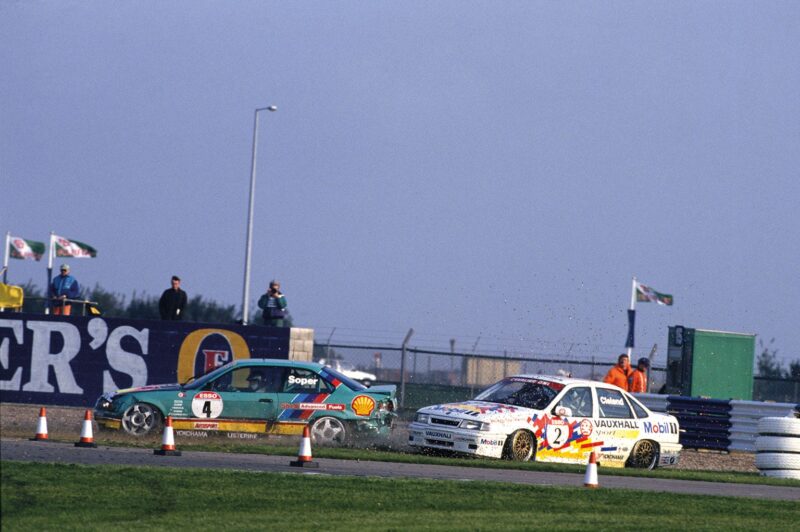
Controversial clash with John Cleland in 1992 BTCC finale at Silverstone
Motorsport Images
“With the demise of the European Championship at the end of 1988 and Ford swinging their budget into rallying, I called BMW again. There was a new guy there from marketing who didn’t know much about the racing programme yet, but he hired me to do the DTM [the German Touring Car Championship]. That was Karl-Heinz Kalbfell. He was brilliant, and went on to run BMW Motorsport for more than 15 years. Sadly he died racing his classic bike at Brands last August.
“There were three teams running BMWs, so eight or nine cars out there. I did 1989 with Zakspeed, had two podiums in my first three races, won a couple, finished fifth in the series. Then I persuaded Kalbfell to bring the Bigazzi team on board. I’d seen Gabriele Rafanelli and Aldo Bigazzi operating, and their whole attitude was the way Italians go racing: have the best cars and equipment you can, but have fun too. I drove for Bigazzi for three seasons.
“Lots of good stories from that period. One of the best was the 1992 Spa 24 Hours, when I was in a Bigazzi M3 with Christian Danner and Jean-Michel Martin. My wife Louise was pregnant, and on Friday evening, after we’ve qualified on the front row, she phones. ‘I’ve gone into labour. Are you going to come back?’ I say to Gabs Rafanelli, ‘I’d better go, I’ll miss the warm-up tomorrow morning, but I’ll be back for the race.’ Drive to Brussels, fly to London, rush to the hospital, but the baby hasn’t arrived. About midnight I say, ‘Look, I’m not staying here indefinitely, I’ve got a 24-hour race to do’. So Louise says to the nurse, ‘My husband says I’ve got to have this baby. Can you help it along?’ Within an hour we have a daughter. It’s tagged up and washed and I walk around with it a bit, then I have a freshen-up, head back to Heathrow, catch the first plane back to Brussels and drive back to Spa to face my second night without sleep.
“The race was really between us and the Schnitzer car of Winkelhock/Heger/van de Poele. On Sunday morning I fell foul of a backmarker in the Bus Stop and we had to fix a bit of bent suspension. That put us a lap down on the Schnitzer guys, so we were going to be a safe second. I did my last stint, got showered, changed and packed up, and told Gabs I was off. But at Bigazzi they always think they can win every race. It doesn’t matter if there’s a rod poking out of the block, they still think they can do it. And Gabs reckoned that either Schnitzer was a pitstop adrift, or they’d have to start preserving fuel. Although Danner was lined up for the last stint in our car, Gabs wanted me back in. I wasn’t happy about it, but I crawl back into my filthy sweaty overalls and out I go, doing qualifying laps every lap, working through the traffic, headlights blazing.”
With an hour to go Steve was back on the same lap as van de Poele. With 15 minutes left he was still 50sec adrift, but van de Poele was being given ‘7500rpm’ pit signals to preserve fuel. “Finally I could see him, I could smell the blood. I switched off my headlights to give him less warning, and with a lap to go I caught him at the Bus Stop. We went down to La Source side by side, and I went ahead.” Steve’s winning margin at the flag was less than half a second, making it one of the closest 24-hour races of all time. “Then I went home to see my daughter. I’m pleased to say we resisted the temptation to call her Frankie, short for Francorchamps.
“When my European races didn’t clash I was also doing some BTCC rounds for BMW, and I was driving for Vic Lee in 1992 when he got arrested for smuggling drugs. He was an intelligent guy, ran an excellent race team, so it was a dreadful shock. BMW went ballistic and said the cars had to be destroyed, burned to nothing. We go to the next race, without Vic of course, and on Friday morning we’re sitting in the transporter waiting for the word from BMW GB: do we unload and run, or do we go home? Finally the call came: we could run. We finished the season, with everybody mucking in to keep it going. Going into the final round at Silverstone, the championship was between Tim Harvey for BMW and John Cleland for Vauxhall. People were there from Munich, there was a lot of pressure. Tim had to finish ahead of John to win it, and my job was to help him.
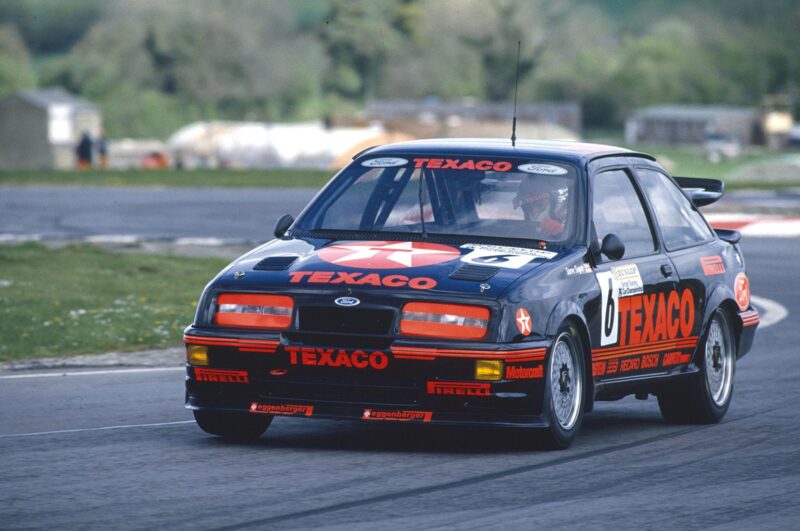
Eggenberger Ford Sierra RS500 pictured at Thruxton in 19998
Motorsport Images
“On lap one I try to pull a move on David Leslie’s Vauxhall and he’s having none of it, and he spins me out. So I’m now stone-cold last. I manage to get back up the field, and with two laps to go I’m fifth, Tim’s ahead of me, Cleland’s behind me. Then John leans on me hard, hard enough to lose his door mirror, and puts me on the grass. He thought that was the end of me, he turned in thinking I wasn’t there any more, but I was there, we collided and we both went off. As I kicked my bent door open to get out he came for me, but the marshals pulled him off me. A lot of the headlines made me the bad guy in all this, but if I’d wanted to spin him off I could have done it without taking myself off and made it look accidental.
“So Tim was champion, but the talk about it went on and on. Finally, six months later, there was an RAC tribunal. John and I hadn’t spoken since, but just before the tribunal he phones me and says, ‘I think you were to blame, you think I was to blame. But they want to make an example and take somebody’s licence, and if they don’t get you they’ll get me. We’ve both got to go into the tribunal and say it was a racing incident’. So we went in separately and said that, and there was nothing more they could do.
“As for Vic Lee, he got 12 years, and served six. I went to see him before it came to court, and he said, ‘I had no choice. I borrowed money from the wrong people, it was either do this or get murdered’. Anything to do with drugs is very hard to forgive, especially if you’ve got kids. Even so I believe everybody deserves a second chance, and in 2004, when I was out of racing and running my first dealership, BMW wanted their dealers to get involved with Formula BMW. Vic had set up again on the back of a lot of work from Peugeot, and we thrashed out a deal: I bought two cars, he bought the running gear, spare body panels, gear ratios. Year one with a guy called Philip Glew we nearly won the championship. We’re getting ready for year two and, clonk, Vic’s arrested. Drugs again. His 28 staff are all out of work. He’s free again now, but I’ll have nothing to do with him. I think I’m a good judge of character, but I got him completely wrong. Out of all the great people I’ve dealt with in 30 years of racing, Vic Lee is the one black mark.

Despite pledging that he’d avoid the Le Mans 24 Hours after his Mazda experience, Soper returned when he became an endurance regular in the mid 1990s. Here he is in action with a McLaren F1 at Mugello
Motorsport Images
“I was disappointed by the following year’s BTCC, with Schnitzer. I was expected to win it – the team said, ‘It’s your country, it should be your championship’. And I expected to win it, I knew all the circuits, they were new to Jo [Winkelhock]. But being honest, and having had a couple of unlucky races, Jo just beat me. I can’t moan at anyone. At Schnitzer Jo was in his family, they were all behind him, he could do no wrong and that made him very difficult to beat.
“In 1994/95, as well as everything else, I raced for BMW in Japan. I think I did 37 trips there and back. I was a working driver and I loved it, even if I didn’t always realise I loved it. Before long I didn’t get jet lag because my brain was so confused, I just went to sleep when I felt tired. I also won the Spa 24 Hours again in 1995 with Jo Winkelhock and Peter Kox, and we went to Macau both those years. It was competitive in Japan – I was up against people like Tom Kristensen and Anthony Reid – but in the first year I very nearly won the championship. BMW said if I went back for 1995, I could choose my programme for ’96. So I went back, and in the second year won the All-Japan Series. Great circuits, nice people, the drivers hard but fair. If you got pushed off and it was the other guy’s mistake, he’d apologise. Very different from what I was used to.
“In 1996 BMW decided to do the BTCC with Schnitzer again. For me that’d be more Croft, Pembrey, Snetterton, circuits I’d driven all my racing life. So I told Bigazzi I’d do the German series with them. One night at home my phone rings, and it’s Karl-Heinz. ‘What’s this about not wanting to race in your home country?’ I say, ‘You told me to race in Japan, I raced in Japan. You and I had a deal that I could choose my ’96 programme. You’re my boss, if you now tell me to race BTCC, I’ll race BTCC. If you tell me to go to Australia I’ll go to Australia. But I’d like to race this season in Germany.’ He says, ‘You shit Englishman,’ and hangs up. That was his way of saying, OK.
“All season we were going to win that German series. Then I’m leading the penultimate round at AVUS and my team-mate is limping back to the pits after banging into somebody. He’s giving me room to go through and at the last moment he turns across me and wipes me out. That was that title gone.
“I’d had Le Mans offers and always stuck to my vow and said no. But for 1996 BMW said, ‘We’re going to do this race until we win it,’ and I thought, I’d better do this. They started with a McLaren F1 run by Bigazzi, which I shared with Nelson Piquet at the Silverstone round as a shakedown. I put it on pole, and in the race we were miles in front, but our guys got their sums wrong, and we ran out of bloody fuel. I spluttered into the pits on tickover, and we finished fourth. Nelson was great: full of mischief and a great practical joker. At Le Mans I was with Jacques Lafitte and Marc Duez, and I was fastest qualifier of the seven McLarens, but we were delayed by a gearbox problem.”
The 1997 GTR McLaren had more power and more downforce, and BMW paired Steve with JJ Lehto in a Schnitzer car, up against the works AMG Mercedes CLKs. With fine victories at Hockenheim, Helsinki, Spa and Mugello, they led the FIA Championship until problems in the last two rounds. “More than all the F1 drivers I’ve had as team-mates – Piquet, Brundle, Nannini, Boutsen – JJ was incredible over a single lap. If you watched his in-car footage it was perfectly smooth, with no excessive steering wheel movement. At first I was driving the GTR too much like a touring car, upsetting it with the throttle, but JJ taught me a lot.”
The 1998 Williams-built BMW V12 was the first open car Steve had ever raced. In the 24 Hours, with Tom Kristensen and Hans Stuck, he was out early with a wheel bearing problem. He did a lot of the development work on the much-improved ’99 car, but now Kalbfell had ceded the running of BMW’s race programme to Gerhard Berger. At Le Mans in ’99 Steve was bitterly disappointed when, despite his proven speed, Berger demoted him to the Dave Price-run ’98 cars. The new car won Le Mans, while Steve, with Tomas Bscher and Bill Auberlen, was fifth behind the surviving Toyota and the Audis. “But Gerhard did put JJ and me in the ’99 car for five ALMS races, and we won three of them. That was the best car I ever raced: everything about it was right.
“I was as quick as I’d ever been, and I was winning on circuits I’d never seen, like Las Vegas and Sears Point. But Gerhard, having retired from F1 when he was 38, didn’t understand why he was paying a 48-year-old to drive. I did some ALMS rounds in 2000 with Jean-Marc Gounon, who’d come from F1, and he set up the car so hard it bounced around Road Atlanta like a football. After Petit Le Mans I said to Louise, ‘I’ve never driven so hard and worn myself out so much to come fourth.’ I could still dig deep, I could still do it, but it didn’t come naturally any more. I decided to stop.
“Then Peugeot asked me to drive a 406 Coupé in the 2001 BTCC. I didn’t want to start another relationship but it was a good deal, all I had to do was turn up and drive. Finally they convinced me. But it was too big and heavy, and you could get either power or torque out of it, but not both. We finally led a race at Oulton by getting our strategy and our pitstops dead right – it was my 100th BTCC start that day – and then a con-rod let go. In the last round at Brands, coming down the hill from Druids, I got helped off by Phil Bennett and went into the barriers. I cracked my helmet and was concussed, but it didn’t seem like a huge accident. Later a brain scan uncovered a serious neck injury. A vertebra was almost touching my spinal cord and it was too dangerous to operate. I consulted three specialists and they all said the same: you’ve got to change your lifestyle. So that was it for racing.
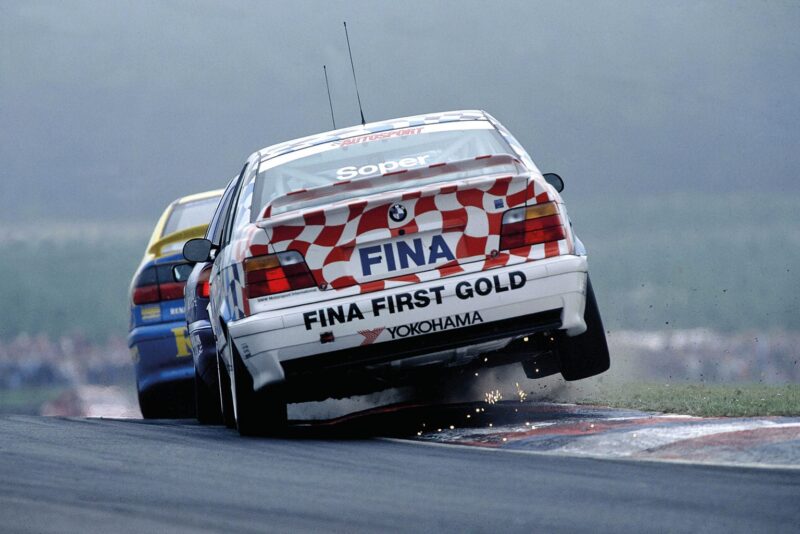
Soper in full flight at Knockhill during the 1995 season with BMW
Motorsport Images
“Back in ’99 I’d taken over a struggling BMW dealership in Lincoln. We turned it around, and it’s now doing well. Later, with Tony Partridge, I invested in another dealership in Hampshire. Then in 2012 I started losing strength in my left arm. A scan showed the spinal thing was now serious, and just a stumble could paralyse or kill me. They had to operate. They went in through the front of the neck, removed three vertebrae and put two carbon cages in. Now my neck’s as strong as a 21-year-old’s. So at last summer’s Silverstone Classic David Cuff put me in his GT40. Then we went to Goodwood. My racecraft was rusty, but there was nothing wrong with my speed – I’d expected it to be the other way around – and I led for a few laps. Now David’s talking about doing Spa.
“Fans still write to me, as many from Germany as from the UK, and they often ask what I think was my greatest race, or my greatest achievement. My answer is always the same: staying employed as a works driver for nearly 20 years, without a year off. That was my achievement, and also my privilege.”
